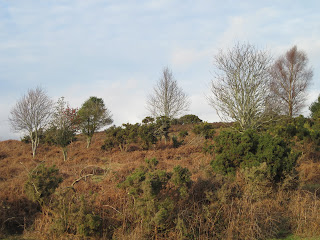
Yesterday, like today, was bitterly cold. I drove down the Avon valley to Christchurch, a market town that dates from pre-Saxon times. The Saxon settlement grew up on land between the confluence of the Rivers Stour and Avon. Its early name was Twynham, the town between the rivers. Its name was changed to Christchurch when the church and the priory were established .
The Priory Church, in the photograph above, is known as Christchurch Priory, although the actual Priory was situated nearby. The first Saxon church on this site was built in the 7th and 8th centuries. The present church was initially Norman and was built in 1094 by Ranulf Flambard. It has been added to and altered over the centuries. The end of the Priory came with the Dissolution of the Monastries by Henry VIII, in 1539, but the church remains to this day as the parish church for the town.

Church Hatch, a fine house at the gates of the Priory Church.

Sign on the old brick wall opposite Church Hatch.

The main door to the Priory Church.

An archway of ancient yew trees in the graveyard in front of the church.

Beautiful external stonework on the north side of the church.

Standing by the eastern end of the church and looking across the walls to sailing boats moored in the harbour.

The east window.

Looking back , westwards, along the north wall.

A narrow "secret" doorway in the wall.

The golden fish (a salmon?) on the weathervane. A symbol of the rich fishing in the rivers and the harbour that have sustained this community for centuries.

A peaceful corner of the graveyard.

A wood pigeon dozes in a churchyard tree.

Back into the main shopping street and looking east along Bridge Street, where the road crosses the River Avon as it flows through the town.

Ye Old George Inn, one of the oldest pubs in the town. It is a favourite with local people and serves a range of local Real Ales. A narrow passageway at the side of the inn leads into Millham Street, a quiet lane that runs parallel to the High Street.

The old market house which now stands in front of the modern shops in Saxon Square. A market was in progress in Saxon Square.
When this shopping centre and the nearby road and underpass were being built, the remains of a Saxon Cemetery were found. The Red House Museum in Christchurch now houses many of the interesting artefacts found during archaeological excavations on the site.
I often come to Christchurch, to the good little independent shops. There is an excellent bookshop where I found some Christmas gifts yesterday. I also just love wandering around the town. We lived on the outskirts of Christchurch for ten years, when the boys were small, so it has many good memories for me. Sometimes I will see familiar faces from the old days and maybe stop to chat with a former neighbour. The lovely old buildings in the town centre and the deep sense of history in the area around the Priory Church make this a town to return to whenever I can.























































